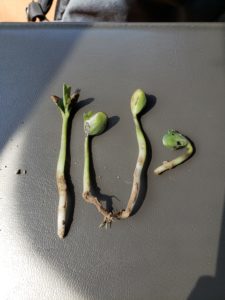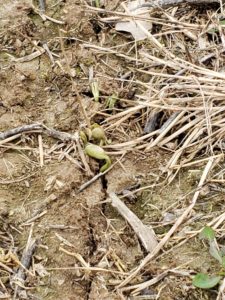This spring has been a roller coaster for sure with respect to planting. Currently we are about 85% planted on corn acres and 20% on soybeans, although this has been one challenging year to get a handle on planting progress for corn statewide.
There has been a lot of variation in corn planting progress reported from county to county, as some counties seem to be pretty close to intended acres with farmers staying in their rotation, and other counties having significant amounts of corn seed returned for soybeans. We started with an overly optimistic planting intention of 1 million acres (USDA forecast for Tennessee), and will likely end up with something resembling our 5 year average, with slight to significant reductions from intended corn acres depending on the county.
Wet soils and cool temperatures have been unrelenting this spring, although corn replant calls have not been too bad. The majority of our corn crop is at the V1 to V3 stage, and although many fields look more yellow with smaller plants (thanks to wet, cool weather), do not appear to have been damaged by temperatures that dipped into the 30’s a week ago. The increase in humidity and temperature this weekend will encourage corn to grow (my plots in Jackson are showing a marked improvement today from just 2 days ago). It is important to get nitrogen on corn as soon as is practical where none was applied at planting or where N loss is suspected. Limited research from UT (Dr. Frank Yin) has shown a significant (9%) improved yield in corn where a nitrification inhibitor was applied to UAN in plots that received heavy rains a week after application in a wet spring. We typically preach more about ammonia volatilization (surface loss) protection, but in fields that tend to wet soils, a nitrification inhibitor product may minimize nitrate leaching and N loss due to denitrification.
Currently, about 20% of our soybeans are planted, and a few calls have come in regarding replants. Although we tend to view corn as being more cold hardy, our soybean crop has done remarkably well through cold, cloudy, wet and the close-to-freezing temperatures of the past week or so. The worst affected plants are in the wettest parts of fields where stands will likely be thin. Based on field observations after last week’s cold front, soybeans that were sprouted or emerging when the front passed through tend to show more low temperature effects than beans that were cleanly out of the ground or with a unifoliate leaf. Sprouted beans with yellow or brownish cotyledons should survive as long as the growing point remains green and there is no visible damage to the seedling stem below the cotyledons. The pictures below are ‘survivors’ from plots here in Jackson. We saw a big improvement in the appearance of beans in this field from Monday to today. 


